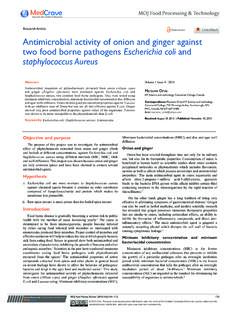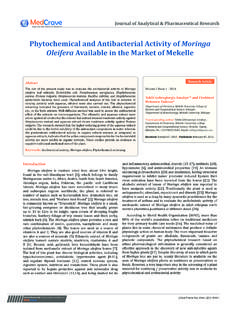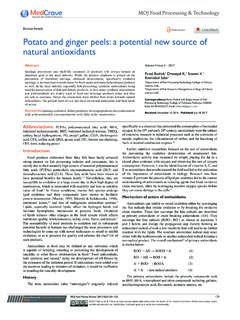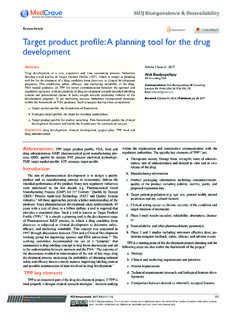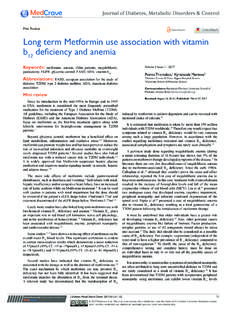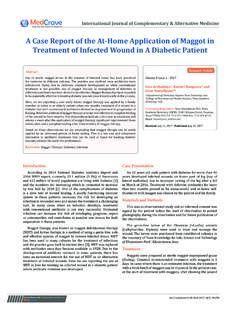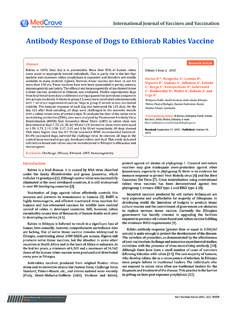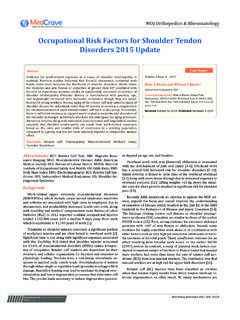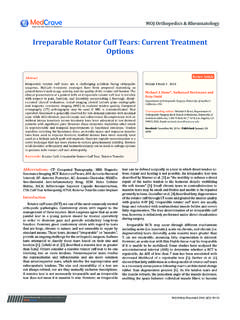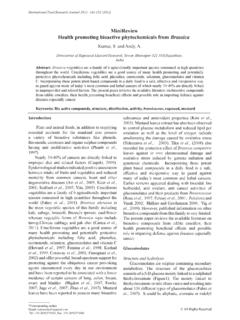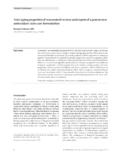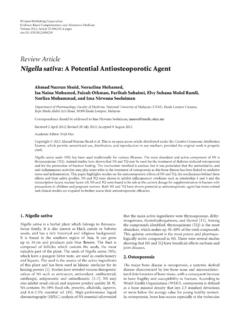Transcription of Microbial Biotransformation: A Process for …
1 Submit Manuscript | are structural modifications in a chemical compound by organisms /enzyme systems that lead to the formation of molecules with relatively greater ,2 This mechanism has been developed by microbes to acclimatize to environmental changes and it is useful in a wide range of biotechnological The most significant aspect of biotransformation is that it maintains the original carbon skeleton after obtaining the is of two types: Enzymatic and Non-enzymatic. Enzymatic are further divided into Microsomal and Enzymatic Elimination is the biotransformation occurring due to various enzymes present in the body. Microsomal biotransformation is caused by enzymes present within the lipophilic membranes of smooth endoplasmic Non-Microsomal biotransformation involves the enzymes which are present within the mitochondria. Examples include: Alcohol dehydrogenase responsible for metabolism of ethanol into acetaldehyde and Tyrosine hydrolases enzymes, Xanthine oxidase converting hypoxanthine into xanthine etc.
2 Spontaneous, non-catalyzed and non-enzymatic types of biotransformation are for highly active, unstable compounds taking place at physiological pH. Some of these include Chlorazepate converted into Desmethyl diazepam, Mustin HCl converted into Ethyleneimonium, Atracurium converted into Laudanosine and Quartenary acid, Hexamine converted into biotransformation is widely used in the transformation of various pollutants or a large variety of compounds including hydrocarbons, pharmaceutical substances and These transformations can be congregated under the categories: oxidation, reduction, hydrolysis, isomerisation, condensation, formation of new carbon bonds, and introduction of functional For centuries Microbial biotransformation has proved to be an imperative tool in alleviating the production of various chemicals used in food, pharmaceutical, agrochemical and other the field of pharmaceutical research and development.
3 biotransformation studies have been extensively applied to investigate the metabolism of compounds using animal The Microbial biotransformation phenomenon is then commonly employed in comparing metabolic pathways of drugs and scaling up the metabolites of interest discovered in these animal models for further pharmacological and toxicological White biotechnology involves the use of Microbial biotransformation for generating products of Living cells such as bacteria, filamentous fungi, animals, plants, algae, yeast and actinomycetes are used. Microbial cells are ideal choice for biotransformation due to certain reasons like: I. Surface-volume ratio: Microbial biotransformation has high surface-volume ratio. II. Growth Rate: Higher growth rate of Microbial cells reduces the time of biomass transformation.
4 III. Metabolism Rate: Higher rate of the metabolism in microbes leads to efficient transformation of substrate. IV. Sterility: It is easier to maintain sterile conditions when microbes are Procedure for biotransformationVegetative cells, spores, resting cells, enzymes, and immobilized cells/enzymes are generally used for Microbial In Process with growing cultures, the strain used is cultivated in a suitable medium and a concentrated substrate solution is added after suitable growth of the culture (6-24h). A variant of this procedure is to use a very large inoculum and to add the concentrated substrate immediately without allowing for a growth period. Emulsifier such as Tween or solvents (water-miscible and low toxic (ethanol, acetone, dimethyl formamide, dimethyl sulfoxide) may be used to help solubilise poorly soluble compounds.)
5 In some steroid transformations, the substrate is added and converted in fine crystalline form. These so-called pseudo-crystalline fermentations can be carried out with relatively high concentrations of Bacteriol Mycol Open Access. 2017;4(2):47 2017 Smitha et al. This is an open access article distributed under the terms of the Creative Commons Attribution License, which permits unrestricted use, distribution, and build upon your work biotransformation : a Process for chemical alterations Volume 4 Issue 2 - 2017 Smitha MS, Singh S, Singh RAmity University Uttar Pradesh, India Correspondence: Singh R, Additional Director, Amity Institute of Microbial Biotechnology, Amity University, Sector 125, Noida, UP, India, Tel +911204392900, Email Received: November 21, 2016 | Published: February 21, 2017 AbstractBiotransformation is a Process by which organic compounds are transformed from one form to another to reduce the persistence and toxicity of the chemical compounds.
6 This Process is aided by major range of microorganisms and their products such as bacteria, fungi and enzymes. Biotransformations can also be used to synthesize compounds or materials, if synthetic approaches are challenging. Natural transformation Process is slow, nonspecific and less productive. Microbial biotransformations or Microbial biotechnology are gaining importance and extensively utilized to generate metabolites in bulk amounts with more specificity. This review was conceived to assess the impact of Microbial biotransformation of steroids, antibiotics, various pollutants and xenobiotic : Microbial biotransformation ; bioconversion; metabolism; steroid; bacteria, fungiJournal of Bacteriology & Mycology: Open AccessMini ReviewOpen AccessJournal of Bacteriology & Mycology: Open Access48 Copyright: 2017 Smitha et : Smitha MS, Singh S, Singh R.
7 Microbial biotransformation : a Process for chemical alterations. J Bacteriol Mycol Open Access. 2017;4(2):47 51. DOI: the biotransformation of lipophilic materials it is possible to employ a polyphase system. The aqueous phase containing the cell material or the enzyme is overlayed with the water immiscible fluid phase in which the substrate has been dissolved. The substrate passes slowly into the aqueous phase and as the transformation reaction proceeds, the product passes back into the solvent phase. In some cases, the actual transformation occurs at the interface of the aqueous and solvent reactions in large-scale equipment are carried out under sterile conditions in aerated and stirred fermenters, the conversion Process being monitored chromatographically or spectroscopically. The Process is terminated when a maximum titer is reached.
8 Maintenance of sterile environment is necessary because contamination can lead to formation of faulty conversion products and can also engage in total cells can be used in case if enzyme induction by the added substrate is not necessary. This has the considerable advantage that growth inhibition by the substrate is eliminated. High cell densities, which promote increased productivity, may be used; at the same time risk of contamination is reduced. Since the transformation reaction occurs predominantly in the buffer solution, the recovery of the product is relatively easy. A number of transformation processes employ immobilized cells, offering the advantage that the Process can be carried out continuously and the cells can be used over and over Immobilized bacterial cells, which catalyse one-stage or multi-stage reactions, are presently used commercially in the production of aspartic acid, L-alanine and malic end products of transformation reactions are found extracellularly and may occur in either dissolved or suspended form.
9 The cell material is then washed repetitively with water or organic solvents in order to detach the reaction product which can be adsorbed to the cells. Depending on the solubility of the product, recovery is performed by adsorption to ion exchangers, by precipitation as the calcium salt, by extraction with appropriate solvents or for volatile substances, by direct distillation from the applications of Microbial biotransformationTransformation of steroids and sterols Steroids constitute a natural product class of compounds that is widely distributed throughout nature present in bile salts, adrenal-cortical and sex-hormones, insect molting hormones, sapogenins, alkaloids and some In 1937 the first Microbial biotransformation of steroids was carried Testosterone was produced from dehydroepiandrosterone by using Corynebacterium sp.
10 Subsequently cholesterol was produced from 4-dehydroeticholanic and 7-hydroxycholestrol using Nocardia spp. All steroids have the same basic structure, a cyclopentanoperhydrophenanthrene which consists of four fused rings (Figure 1).18 Cortisone is very useful because of its anti-inflammatory action against rheumatold arthritis and skin diseases. By changing the structure, specifically by incorporating a 1,2 double bond in ring A of the cortisone molecule to produce prednisone which have the property of markedly increased anti-inflammatory steroid molecule has several asymmetric centres and it makes the total synthesis of steroid very Preliminary research on the 11 alpha-hydroxylation of progesterone pointed to the possibility of the Microbial introduction of oxygen into the steroid nucleus in a site specific and stereospecific manner without prior activation (Figure 2).
